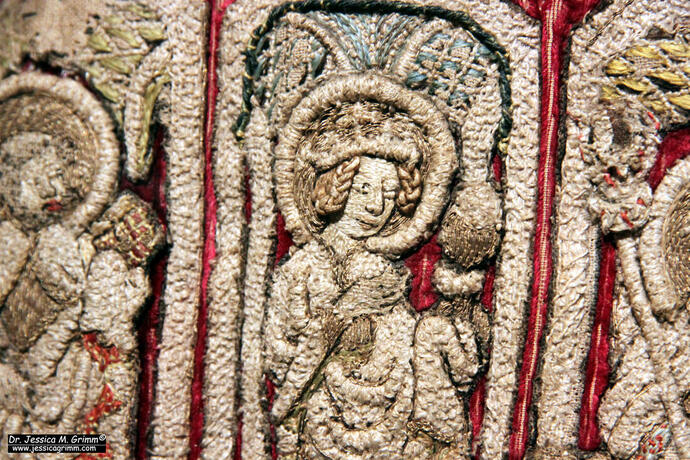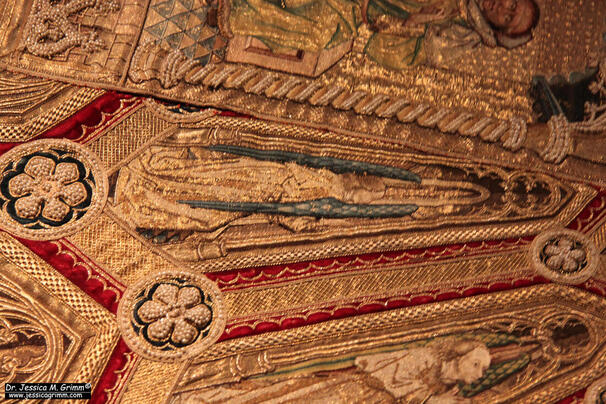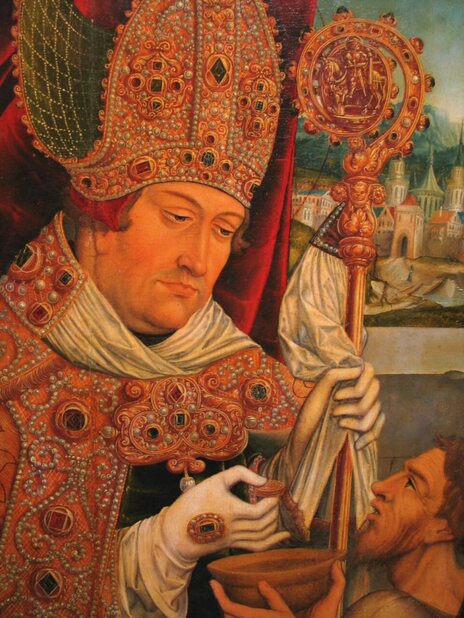|
If you like to embellish your embroidery with beads you are a part of a very old tradition. Especially goldwork embroideries have been made even more exquisite by adding fresh-water pearls, beads made of precious stones, coral or metal. Those of you who use beads in your embroidery will know that you need to secure them well or else you run the risk of them coming off. Small wonder that many beads have now vanished from medieval embroideries. However, they have left traces on the original pieces and in contemporary sources. Let's explore! On the medieval embroideries themselves, you often see these areas of thick white string padding. Sometimes identified in the literature as silk, cotton or linen. Especially fresh-water pearls would have been attached on top of this white string padding. Not only does this mean that texture is added to the embroidery but it also ensures that the light catches the pearls first and makes them stand out even more. After all, when you are spending a lot of money on these extra embellishments you want the onlookers to take note of your generosity. Another source of medieval bead embroidery forms the many paintings which depict clergy in their finery. Some painters were specialised in faithfully rendering the costly embroideries on vestments. Possibly because they were also the ones who made the design drawings for these embroideries. For instance, painter Mathias Grünewald faithfully painted the pearl embroidered mitre his friend the silk embroiderer Pflock made (Halm 1957). And our third source is a collection of books written by the monk Theophilus in the 12th-century on a range of crafts: Schedula diversarum artium. You can find a collection of all the known versions of this manuscript together with three translations (Dodwell for English, Ilg for German and Ecalopier for French) on the website of the University of Cologne. The English translation of the passage on the use of fresh-water pearls reads as follows: "Pearls are found in shells of the sea and other waters. They are pierced through with a fine steel drill, which is fixed in a wooden shaft and a block of wood [at the top]. On the shaft is a small lead wheel and, attached to it is a bow by which it is rotated. If it is necessary for the hole of any pearl to be made larger, a wire is inserted in it together with a little fine sand. One end of the wire is held in the teeth, the other in the left hand, the pearl is moved up and down with the right, and sand is meanwhile applied so that the hole becomes wider. Mother of pearl is also cut up into pieces. These are shaped into pearls with the file they are most useful on gold and are polished as above." The pearls are so small (1-1.5 mm ), and their holes thus even smaller, that loose pearls can only be reattached during restoration with the help of fine surgical needles (Herrmann 1975).
You can get a better idea of how beads were being made by looking at the drawings of the Hausbücher of the Nürnberg Zwölfbrüderstiftungen. There are three depictions of brethren working a lathe borer to drill beads for a rosary. The oldest one dates from before AD 1414. From the same Hausbücher, we have a depiction of brother Alexander Hohlfelder. He was taken into the almshouse on the 3rd of April AD 1626 when he was 80-years old. Alexander had lost his speech and likely had dementia when they took him in. He died after two more years in the almshouse. Alexander had been a Seidensticker (silk embroiderer) and is depicted with a bead dish filled with what looks like fresh-water pearls. Literature Halm, P., 1957. Matthias Grünewald: Die Erasmus-Mauritius-Tafel. Reclam, Stuttgart. Hermann, H., 1975. Die Restaurierung einer spätmittelalterlichen Perlenstickerei, Maltechnik restauro 81 (3), p. 113-115.
10 Comments
Mabel
15/2/2021 15:16:22
Hoi Jessica, wat een geweldige informatie geef jij toch altijd! Petje af en dankjewel.
Reply
15/2/2021 15:57:45
Graag gedaan, Mabel! En dank je wel voor de complimenten :).
Reply
Nancy B
15/2/2021 16:15:38
Fascinating as always, Dr G. I often wondered how painters were able to render stitch, such as blackwork, so faithfully in their portraits. The suggestion that they either were the designers or knew the designers, and therefore were familiar with the designs, is a new one for me. Thanks!
Reply
15/2/2021 16:45:53
Thank you, Nancy! As I am moving away from the purely embroidery literature and into the art historical literature, I find more and more of these connections. And it completely makes sense to befriend a painter. Just think of all the modern embroiderers who say that they cannot draw :).
Reply
Alicia D Clark
15/2/2021 17:51:13
OK, I give up. How was the braided hair done in the first picture? It looks to be padded, but how? Satin stitch then outline individual sections? Beautiful piece.
Reply
15/2/2021 18:00:39
Good question! I had a look at the other pictures I took and I think they braided heavier linen threads and then turned the braid upwards. They then satin stitched each "braid bump" seperately with brown flat silk (I think I see traces of it). A bit like trailing in fine whitework. This would be such a fun experiment!
Reply
Poppy T
15/2/2021 19:39:03
I just think of the eyesight and dexterity that would be required to drill pearls, and then attach them. Knowing how small surgical needles are and unfortunately easy to lose...we often find them because of the attached suture material. I wonder if pearls were recycled from old to new objects and explain areas where none are left? I think of things like drizzling.
Reply
15/2/2021 19:44:58
I think this is where all short-sighthed medieval people found employment :). Yes. pearls were recycled. They also formed a kind of a piggy bank for when the owner needed money.
Reply
17/2/2021 16:57:11
It just makes you want to have a time machine. And then watch in awe and ask them lots of questions. When you then tell them that in the 21st century we have trouble to achieve their standards, they will shake their heads in disbelieve and think you are possessed :).
Reply
Your comment will be posted after it is approved.
Leave a Reply. |
Want to keep up with my embroidery adventures? Sign up for my weekly Newsletter to get notified of new blogs, courses and workshops!
Liked my blog? Please consider making a donation or becoming a Patron so that I can keep up the good work and my blog ad-free!
Categories
All
Archives
July 2024
|
Contact: info(at)jessicagrimm.com
Copyright Dr Jessica M. Grimm - Mandlweg 3, 82488 Ettal, Deutschland - +49(0)8822 2782219 (Monday, Tuesday, Friday & Saturday 9.00-17.00 CET)
Impressum - Legal Notice - Datenschutzerklärung - Privacy Policy - Webshop ABG - Widerrufsrecht - Disclaimer
Copyright Dr Jessica M. Grimm - Mandlweg 3, 82488 Ettal, Deutschland - +49(0)8822 2782219 (Monday, Tuesday, Friday & Saturday 9.00-17.00 CET)
Impressum - Legal Notice - Datenschutzerklärung - Privacy Policy - Webshop ABG - Widerrufsrecht - Disclaimer









 RSS Feed
RSS Feed